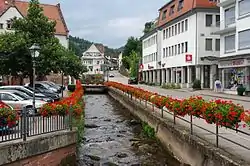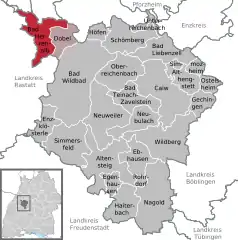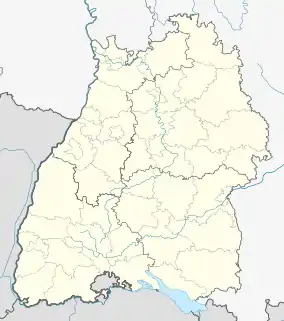Bad Herrenalb
Bad Herrenalb is a municipality in the district of Calw, in Baden-Württemberg, Germany. It is situated in the northern Black Forest, 15 km east of Baden-Baden, and 22 km southwest of Pforzheim.
Bad Herrenalb | |
|---|---|
 | |
 Coat of arms | |
Location of Bad Herrenalb within Calw district  | |
 Bad Herrenalb  Bad Herrenalb | |
| Coordinates: 48°48′2″N 8°26′27″E | |
| Country | Germany |
| State | Baden-Württemberg |
| Admin. region | Karlsruhe |
| District | Calw |
| Government | |
| • Mayor | Norbert Mai |
| Area | |
| • Total | 33.03 km2 (12.75 sq mi) |
| Elevation | 365 m (1,198 ft) |
| Population (2019-12-31)[1] | |
| • Total | 8,000 |
| • Density | 240/km2 (630/sq mi) |
| Time zone | UTC+01:00 (CET) |
| • Summer (DST) | UTC+02:00 (CEST) |
| Postal codes | 76332 |
| Dialling codes | 07083 |
| Vehicle registration | CW |
| Website | www.badherrenalb.de |
The town is connected to the city of Karlsruhe by the Albtalbahn, an electric railway that forms part of the Karlsruhe Stadtbahn. Bad Herrenalb is the terminus of one of the branches of the Albtalbahn, which operates as line S1.[2]
History
The town grew up around Alba Dominorum, a Cistercian monastery founded in 1148. The monastery was later dissolved during the Reformation. As early as 1841 Dr. J. Weiss established a cold water sanitarium which was later transformed into a water therapy institute with a sanitarium for nervous disorders. The sanitarium was further developed under the leadership of Councilor Dr. Mermagen.
Since 1954 Herrenalb is officially known as a “health resort.” In 1971 a 600 meter deep well was drilled into a mineral rich water source. With the exploitation of this source, Herrenalb officially appended the word “Bad” (German for bath) to its name on July 26, 1971.
On January 1 and February 1, 1972 the Rotensol and Neusatz were respectively incorporated into Bad Herrenalb. And finally, on January 1, 1975 Bernbach was likewise incorporated into the municipality.
Mayors
References
- "Bevölkerung nach Nationalität und Geschlecht am 31. Dezember 2019". Statistisches Landesamt Baden-Württemberg (in German). September 2020.
- Eisenbahnatlas Deutschland. Verlag Schweers + Wall GmbH. 2009. p. 93. ISBN 978-3-89494-139-0.